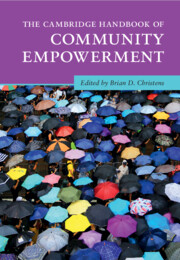Book contents
- The Cambridge Handbook of Community Empowerment
- Cambridge Handbooks in Psychology
- The Cambridge Handbook of Community Empowerment
- Copyright page
- Contents
- Figures
- Tables
- Contributors
- Building Community Power
- Part I Organizing and Activism
- Part II Participatory Governance
- Part III Civil Society and Coalitions
- Part IV Enterprise
- Part V Participatory and Community Arts
- Part VI Education and Engaged Research
- 20 Action Civics
- 21 Gender–Sexuality Alliances
- 22 Youth Participatory Action Research in School Settings
- 23 Community-Based Education
- 24 Community-Engaged Research
- Concluding Thoughts on Building Community Power
- Contributor Details
- Index
- References
20 - Action Civics
from Part VI - Education and Engaged Research
Published online by Cambridge University Press: 18 April 2024
- The Cambridge Handbook of Community Empowerment
- Cambridge Handbooks in Psychology
- The Cambridge Handbook of Community Empowerment
- Copyright page
- Contents
- Figures
- Tables
- Contributors
- Building Community Power
- Part I Organizing and Activism
- Part II Participatory Governance
- Part III Civil Society and Coalitions
- Part IV Enterprise
- Part V Participatory and Community Arts
- Part VI Education and Engaged Research
- 20 Action Civics
- 21 Gender–Sexuality Alliances
- 22 Youth Participatory Action Research in School Settings
- 23 Community-Based Education
- 24 Community-Engaged Research
- Concluding Thoughts on Building Community Power
- Contributor Details
- Index
- References
Summary
Action civics is a model for civic education that offers youth opportunities to participate in authentic democratic activities. In this chapter, we trace the origins of action civics and explore the field’s defining features, strengths, and challenges. We frame our analysis through two case descriptions of action civics intermediary organizations: Generation Citizen and Design Your Neighborhood. We discuss action civics education as a psychologically empowering process, and we illustrate tensions that arise as youth develop psychological empowerment. Through these examples, we reveal features of the action civics process model that support community power in the situational, institutional, and systemic domains. We explore empowering characteristics of empowering settings that are present in Design Your Neighborhood and Generation Citizen. These include common belief systems, a relational environment that supports intergenerational partnerships, opportunity role structures, opportunities to develop local leadership, and external linkages to community stakeholders. Our chapter concludes with recommendations for practitioners, researchers, and other stakeholders to consider as the field of action civics expands.
Keywords
- Type
- Chapter
- Information
- The Cambridge Handbook of Community Empowerment , pp. 507 - 531Publisher: Cambridge University PressPrint publication year: 2024



